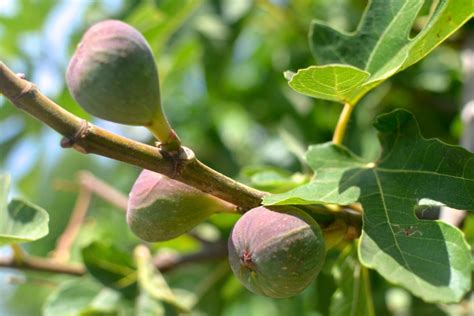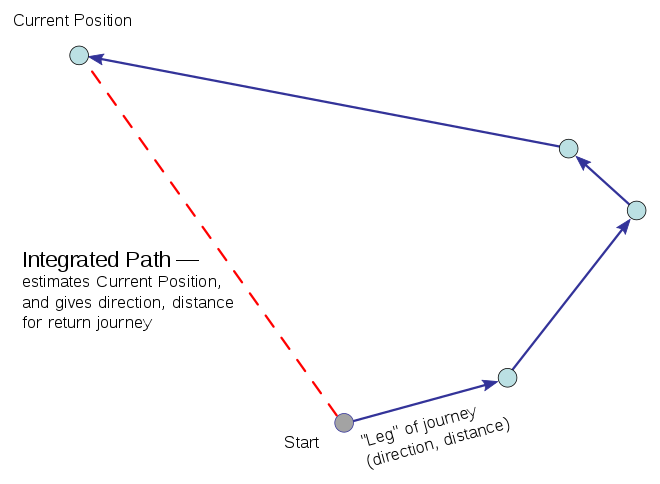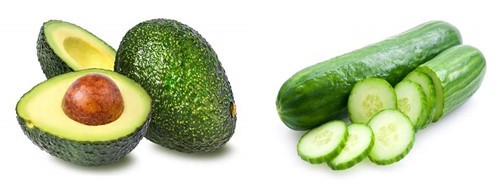
Spatial cognition is created by a suite of mechanisms.
Does this suite include adaptations specialized for remembering the locations of edible plants?
In many cognitive tests tapping spatial cognition and navigation, men outperform women. Many psychologists assumed that this male advantage is general, holding across spatial problems and domains. But it is not.
There is a sexual division of labor in hunter-gatherer societies, with men specializing in hunting and women specializing in gathering stationary resources, such as plant foods. These tasks place different demands on spatial cognition. Animals move from place to place, and they do their best to evade their predators. Tracking an animal can take a hunter into unknown territory. Returning to camp in an energy efficient way requires the ability to compute the shortest distance between your current position and your camp, which is a straight line. This can be done by path integration. Spatial tasks showing a male advantage, such as mental rotation, are thought to tap this navigational skill.

Path integration sums the vectors of distance and direction travelled from a start point to estimate current position, allowing an animal to compute a straight line path back to the start. Desert ants navigate this way.
Plants, by contrast, stay in one place. But when a forager encounters a plant, the berries may need another week to ripen, the vine may be too young to have produced a mature tuber, and it may be a month before mature nuts appear on the mongongo tree. A hunter who is opportunistically harvesting plants as he tracks animals does not need to remember the location of plants that are of no immediate use. But being able to relocate a plant at a later time, when it has become harvestable, is important for a forager who specializes in gathering edible plant foods. And, although foraging women occasionally hunt small animals when the opportunity arises, they typically specialize in gathering plants and other sessile (permanently attached) resources.
To return to these sessile resources when they are harvestable, a forager needs to remember their location at two scales. The first scale is within a patch: this requires encoding an edible plant’s position relative to other plants and landmarks in a tangled bank of vegetation. Based on this adaptive problem, Erwin Silverman and Marion Eals looked for and found a female advantage in object-location memory, which was content-general—as it should be, given the need to encode the position of edible plants relative to rocks, trees, and other objects (see their chapter in The Adapted Mind, 1992).
The second scale is one that supports navigation back to the resource patch at a
later time. Navigation at this scale requires encoding the resource’s absolute location
within a represented environment—a quite different task, more similar to path integration.
Are there spatial adaptations specialized for gathering?
Are there spatial adaptations specialized for gathering, which cause women to spontaneously encode the location of plant resources and then navigate back to them later? And are these adaptations chronically activated in women, so that they pick up this information incidentally, as they go about other tasks? To find out, CEP researchers conducted their first study at a farmers’ market in Santa Barbara.
Spatial adaptations for foraging: Women excel and calories count by Joshua New, Max M. Krasnow, Danielle Truxaw, and Steven J. C. Gaulin (2007) in Proceedings of the Royal Society, Biological Sciences.

Santa Barbara Farmer’s Market, where the study was done.
After taking people around the market and having them taste and rate foods at different stands, the researchers brought subjects back to a place where they could not see any of the stands and asked them to point to where each of the foods had been—a task that taps both spatial memory and the kind of vector integration necessary for efficient navigation. Women outperformed men—an advantage that held even when the researchers controlled for a variety of experiential variables, including visits to the farmer’s market and particular stalls, how often they eat each food, and how much they liked each food they had tasted (none of which predicted any variance in pointing accuracy). This is not because the researchers happened to find a particularly gifted sample of women: Men scored higher than the women did on a general not-plant-related sense-of-direction test (one that also predicted unique variance in pointing accuracy across sexes).
Calories count

Caloric density is calories per unit volume. Caloric density is high for avocados, low for cucumbers, for example.
An adaptationist approach to sex differences can slice a domain with remarkable precision, a point nicely illustrated by a second finding from the farmer’s market study. Although the sexual division of labor among hunter-gatherers suggested the hypothesis that women will have an advantage in remembering the location of gatherable resources, the nutritional quality of the resource should be relevant to both sexes.
Optimal foraging theory was developed by behavioral ecologists to predict and explain
which species foragers will harvest. Not surprisingly, its formal models have
identified a food’s caloric density as one important predictor of whether foragers will spend time searching for it. This led the farmer’s market researchers to ask what would otherwise be a very strange question for a traditional cognitive psychologist: All else equal, are people more accurate at pointing to the location of foods of higher caloric density? Is their spatial/navigational performance better for, say, avocados and almonds than for cucumbers and lettuce?
The answer is yes: Calories count for both sexes. There was a robust correlation between a food’s caloric density and accuracy at pointing to its location. This was not because people preferred the taste of high-calorie foods: Subjects had rated how much they liked each food during the initial tasting-and-rating phase of the study, but there was no correlation whatsoever between how much they liked each food and their pointing accuracy. Moreover, the extent to which calories improved spatial memory was independent of sex and had a similar effect size for women and men.
Cognitive adaptations for gathering-related navigation in humans by Max M. Krasnow, Danielle Truxaw, Joshua New, Hiroki Ozono, Shota Uono, Taiji Ueno, & Kazusa Minemoto (2011) Evolution and Human Behavior.
The researchers then took a deep dive into this topic, by comparing location memory for pictures of fruit on a tree to memory for many other categories, including animals, buildings, electronics, jewelry, and tools. In this 2011 study, they assessed how well people remembered which objects they had seen (identity memory), as well as their memory for where these objects were located (location memory).

These researchers found a female spatial advantage for fruit on trees, which replicated across four studies conducted in the US and Japan. More importantly, they showed that women’s better memory for the location of fruiting trees was not caused by differences in their ability to remember the identity of food resources they have seen. Because they tested whether subjects remembered having seen specific pictures (regardless of their location), the researchers could assess location memory when controlling for identity memory. The only category that showed a female advantage in location memory after controlling for identity memory was fruit-on-trees. There was no replicable tendency for men to outperform women on location memory for any of the six categories tested.
Maybe each sex is better at remembering the location of objects from categories that tap gender stereotypes. Can this explain why women remember the location of fruiting trees better than men do? No. In Japan, subjects were also tested on electronics and jewelry, because gender-stereotypes there hold that electronics are more interesting to men and jewelry to women. But men did not outperform women on location memory for electronics (or anything else). And, while women were better at remembering which pieces of jewelry they had seen (identity memory), there was no sex difference in location memory for jewelry after controlling for identity memory.
Differences in attention?
Because they used an eye-tracker in Study 3, the researchers could examine the relationship between attention–how long a person looked at each photo–and spatial memory. There was no sex difference in how much men versus women attended to fruit on trees (or any other category), so it is unlikely that men were simply distracted during the task or inattentive to plants.
Incidental learning is unplanned learning, which occurs without volitional attention. In an incidental learning condition, subjects were given a task that does require volitional attention: They were asked to report how many buildings were in each photo array. These subjects did not know they were going to be asked about the location of objects later. In a directed learning condition, the same subjects were told to pay attention to all the photos, so they could do well later when asked which photos they had seen and where they were.
Women’s location memory for fruiting trees was better than men’s in both conditions. And within each condition, women who paid scant attention to plants (as measured by looking time) remembered their locations as well as those who paid a lot of attention. This means women were picking up fruiting tree locations automatically, even when they were counting buildings. This was not true for men. In the incidental learning condition, attention mattered: the more time men spent looking at fruiting trees, the better they remembered their locations.
When men (and women) were asked to pay attention to all the photos (directed learning), they remembered the locations of fruit trees better than in the incidental condition. Even though the directions motivated greater attention in both sexes (as measured by looking time), women still outperformed men on location memory for fruiting trees–but not for other categories.
When women are foraging, automatic, incidental learning for plant locations is a felicitous design feature. It means that as women attend to other things–digging roots, gathering nuts, talking with their friends, watching their children–they will nevertheless pick up valuable information about plant locations, which they can use in the future.
Taken together, the results show that women have better spatial memory than men for the absolute location of plant foods within a spatial frame. This female spatial memory advantage was highly domain specific: It was elicited only by fruiting trees. No spatial sex differences were found for other categories tested, including buildings, animals, tools, or gender-stereotyped objects, including jewelry and electronics.
Content matters
A psychologist expecting to find spatial and navigational processes that operate independently of content would never think to look for any of these plant-specific effects. Nor were they stumbled upon during more than 50 years of intuition-driven research in spatial cognition. Yet they were prior predictions, in advance of any data, by the evolutionary psychologists involved.
That calories count for navigation—that high-caloric-density foods activate better
spatial memory and processes for returning to their location—is a result undreamt of in the philosophy of most cognitive scientists. So is the discovery that women have a spatial advantage that is not found for most objects, but emerges when the task involves gatherable plant resources. These surprising results imply that content matters deeply: Embedded within the computational systems that govern spatial memory and navigation are elements that respond differentially to plant resources and to the caloric density of foods.
Press and responses
Press coverage of the PRS 2007 paper included pieces by Science, The Economist, and The Daily Telegraph
The Science coverage prompted a letter from Brumfiel, Di Leonardo, Hoffman, Kuzawa, McDade, Schwartzman and Seligman (Northwestern University, Anthropology Department) that was critical of our paper.
The CEP researcher’s response to Brumfiel et al. was published by Science along with their letter: PDF
Unfortunately, several unapproved changes were made to our letter after we approved the proofs, and they were published in the print edition of Science. Our intended letter of response can be accessed here: PDF.
One issue in specific we feel most especially needs to be addressed. In our actual response we made the argument that the human sexes differ in a number of ways, and that any attempt at egalitarian policy must be mindful and informed of these differences to be effective. We characterize Brumfiel et al.’s claims of biological identity as a weak commitment to egalitarianism in name only that is in fact counterproductive. Unfortunately, the letter as published makes it sound as if we are not committed to egalitarianism, which is absolutely not the case.







